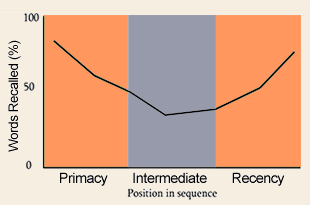The recency and primacy effects—long documented phenomena related to the importance of sequence on information recall—evidence that, in short, “Following a single exposure to learning, recall is better for items at the beginning (primacy) and end (recency) […] than for middle items.” [1]
better for items at the beginning (primacy) and end (recency) […] than for middle items.” [1]
This is relevant to teaching and learning because it’s in that middle period, when many faculty have come to the heart of their lesson, that students may be least likely to be actively learning.
In the book, Student Engagement Techniques, [2] Elizabeth F. Barkley poses the suggestion that lectures could be shaped around this retention curve by segmenting a class into three parts:
1) Begin the class by diving directly into teaching important content.
2) After 20 minutes or so, have students take a brief break, stand up and stretch, and then conduct the administrative business, i.e., attendance, collection of homework, distribution of graded homework, etc.
3) Finally, transition back into important content for the last part of class. Consider incorporating a “JiTT” activity (Just in Time Teaching Techniques, October 10, 2012) and close the class with a recap of the most important points.
Notes
- Primacy Versus Recency in a Quantitative Model: Activity Is the Critical Distinction Anthony J. Greene, Colin Prepscius, and William B. Levy
- A CTL favorite book: Student Engagement Techniques (p.103)
